Psoriasis (translated from Greek "psora" - "skin disease, crust) is a chronic pathology of a non-infectious nature, also known as scaly lichen, which mainly affects the skin at the knee and elbow joints, lower backThere is also psoriasis of the joints, bones, nails, external genitalia and internal organs, but these forms are rarely diagnosed. The pathology is difficult to cure, therefore, when the first symptoms appear, red rashes, a needurgent to consult a doctor.
Symptoms
Stearine stain
The first sign of psoriasis, which is part of the triad of pathology symptoms. It is characterized by the addition of skin after scratching the affected area with a spatula. Over time, there is a separation from the papules of the silvery white scales. Removing them is not difficult, as they become loose and poorly adhere to the psoriatic papule. The surface of neoplasms (rashes) turns white, and the particles crumble and look like shavings.
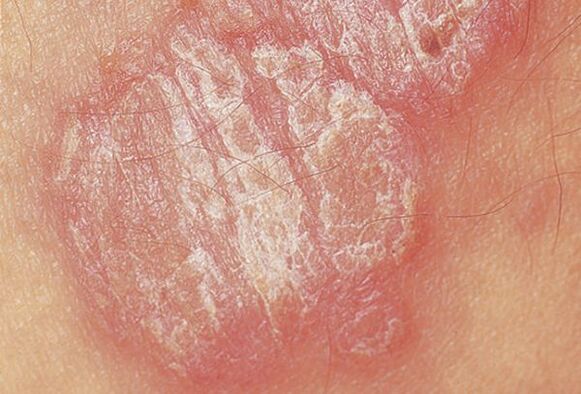
The first triad phenomenon is explained by the development of parakeratosis (improper functioning of the epithelium, which leads to a violation of the formation of the corneal layer). To combat deviations in the initial stage, local non-hormonal agents (creams, oils) are used.
Terminal films
It is characterized by the removal of a thin layer of tissue from the papules, which has a shiny structure and looks like polyethylene. It is easily separated from any impact (pressure, friction, etc. ) after removing the dried flakes.
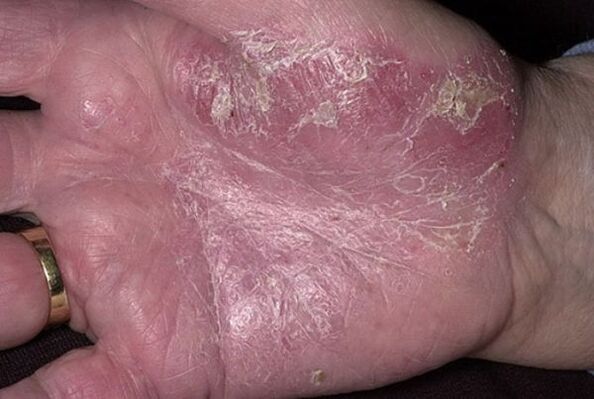
The terminal film is the last layer to be removed from the skin. Further scraping leads to the final stage of the triad - drip bleeding.
At this stage, medicinal herbal baths, medicines with antiallergic effect, oils on natural bases (without corticosteroids and hormones) are used.
Accurate bleeding
After removal of the terminal film, dripping bleeding occurs in the affected area of skin (symptom of auspit or "bloody dew") and accelerated growth of neoplasms is observed, which sometimes reach the size of a pea and are called lentils. In some cases, the papules grow to the diameter of a small coin and differentiate as nummular. As the disease progresses, their growth increases and when combined, psoriatic plaques form.
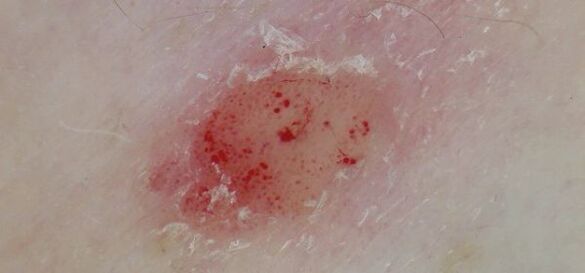
For treatment, retinoids, immunomodulators, anti-inflammatory drugs, physiotherapy are used.
Others
The disease can be recognized by other characteristic signs, the main of which are 4:
- The edge is red, not scaly, which forms around the papules.
- In a clean area of skin, small rashes are visible (usually appear before the progressive stage of psoriasis).
- A symptom that helps distinguish psoriasis from seborrheic dermatitis is characteristic of the active phase of the pathology. Accompanied by the appearance of papules with clear borders on the scalp; this does not happen with seborrheic dermatitis.
- A light and shiny edge of the skin appears around the formation. The symptom is typical of the regression phase of the disease and appears when the papules disappear.
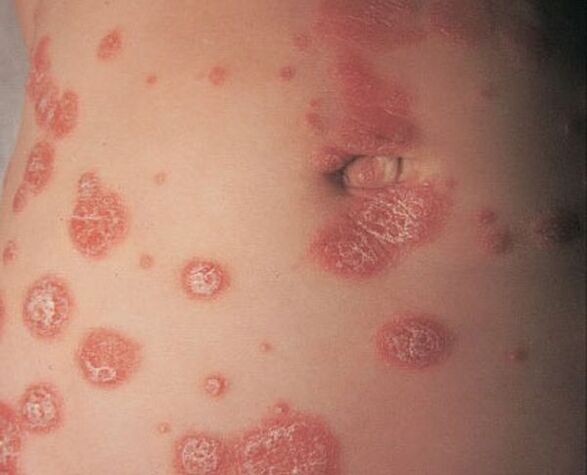
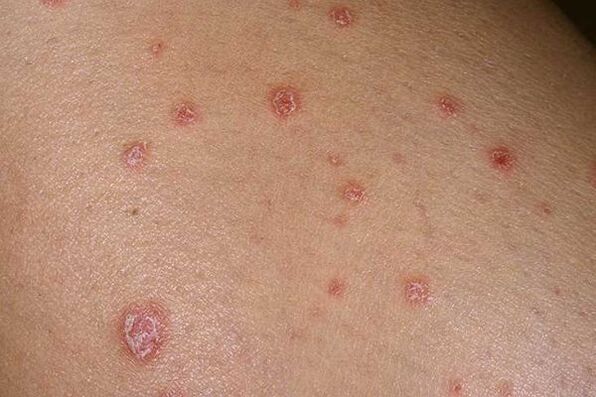
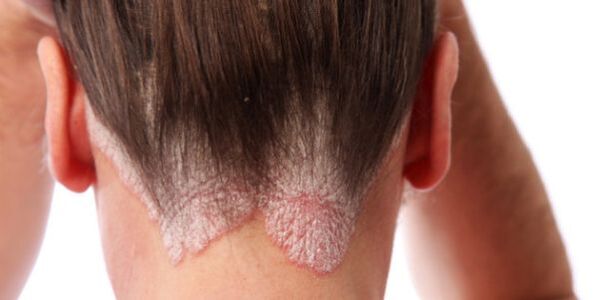
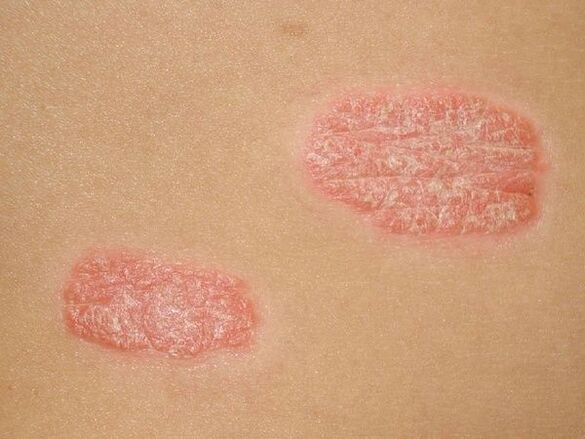
How does it look
In most cases, the onset of pathology is invisible: at an early stage, psoriasis affects small areas of the skin, mainly in the curves of the limbs, scalp and along the hairline.
Attention!Initial manifestations occur at the site of persistent mechanical skin irritation, for example, where the dressing is rubbed and pressed.
Common symptoms:
- itching;
- excessive dryness of the skin;
- peeling of pathological elements;
- general deterioration of health (weakness, lethargy, fever).
There are 3 stages in the development of pathological papules:
- Progressive.The appearance of a rash of a bright pink color, surrounded by a rich, slightly blurred lip. In the center of the papule, the skin peels off, giving the formations a white color. At this stage, redness may appear at the site of scratches, skin damage, bites, cuts, piercings or burns.
- Immobile. It starts 1-4 weeks after the onset of the disease. New plaques do not appear, old ones take on a lighter color, skin intensity decreases.
- Regressive.The color of plaques and papules fades, their infiltration is reduced and the formations disperse. The average duration of the breakdown period is from 2 to 6-8 months.
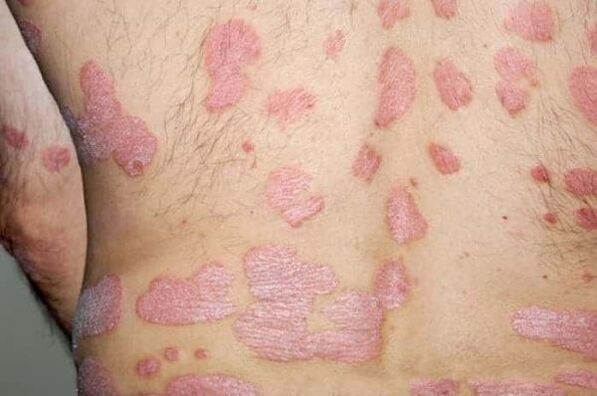
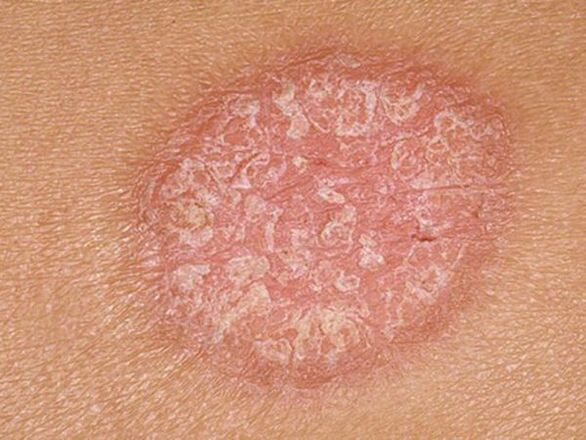
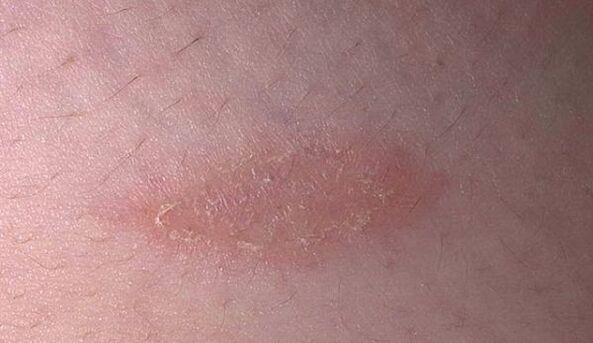
Symptoms of the disease depending on the type:
- plates(common or vulgar). The most common type of pathology. On various parts of the body (most often on the elbows, knees, head), oval or round plates of a red color appear, covered with silvery white scales on top.
- Seborrheik.It mainly occurs on the scalp. Manifested as peeling and itching, it spreads to the area behind the ears and skin along the hairline.
- Pustularthe type is considered the most severe form, develops rapidly and affects large areas of skin. Painful rashes appear on the body, which are accompanied by a local increase in temperature, weakness, headache, diarrhea. Exudate-filled vesicles quickly form into lesions. In the future, the spots progress, merging with each other, forming large lesions on the body.
- Intertriginous.Typical for children, accompanied by the appearance of bright red papules, with light skin (may not be there).
- Exudative.The affected areas of the skin are not only peeled off, but also become quarters, creating yellow crusts on the surface of the tiles.
- Psoriatic erythroderma.Red plaques with silvery, yellow or white scales are observed all over the body. It is accompanied by an increase in lymph nodes, an increase in body temperature. In the future, the formations coalesce into large spots that cause irritation and itching.
- Psoriatic arthritis.It is accompanied by "articular syndrome", in which the skin in the joint area is affected (in the wrists, phalanges of the fingers, spine, and so on) and if measures are not taken in a timely manner, the disease affects the joints.
- Tear dropsaccompanied by abundant rash, consisting of many small plaques. In this case, the papules are in the form of dots, their color is from bright red to purple.
- Points.It is characterized by the formation of small spots in different areas of the body, resembling spots and there may be no peeling of the dermis.
- Rupioid.One of the types of chronic psoriasis. In formations crusts appear, they become higher, taking the shape of a cone.
- Oldmanifests in large papules that do not pass for a long time, sometimes papillomas and warts form on them.
- Psoriatic onyxleads to deformation of the nails, the appearance of yellow-brown spots under them.
- Palmar-foot.Appears on the palm and heel. The main symptoms are thickening of the skin, dryness, cracks.
- Psoriasis of the mucous membranesaffects the oral cavity and provokes the appearance of plaques on the mucosa.
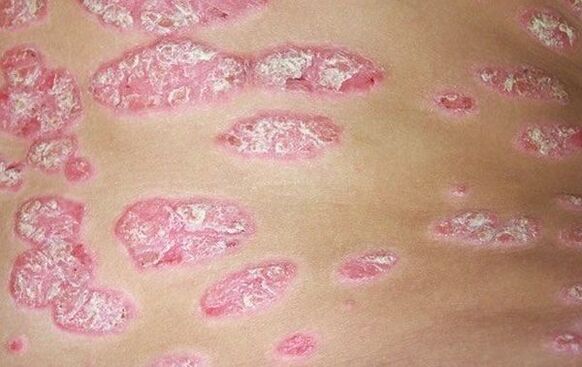
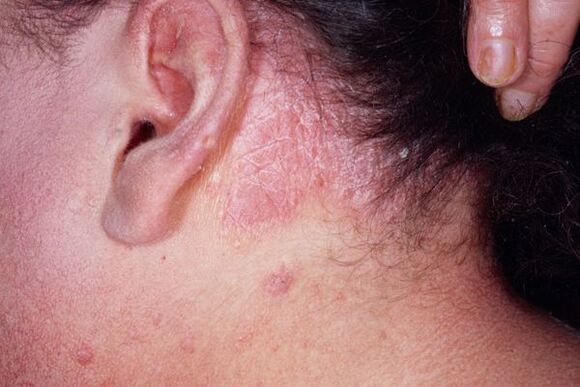
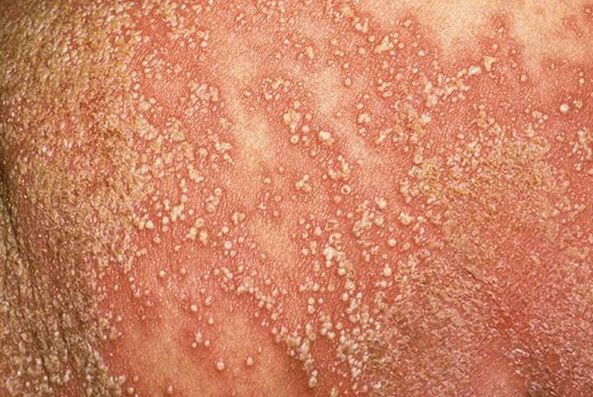
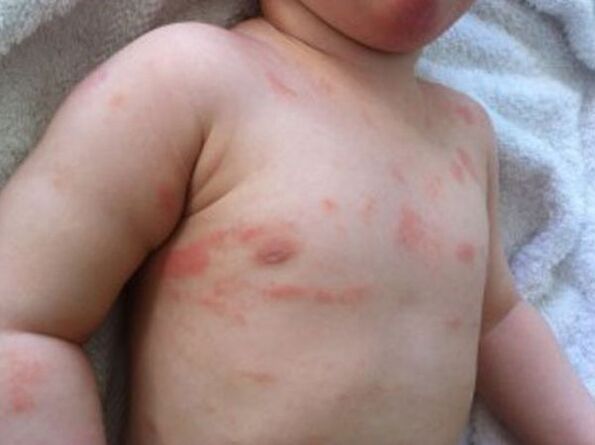
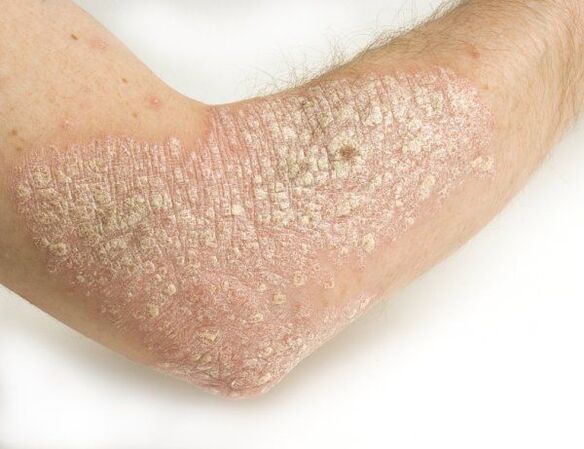
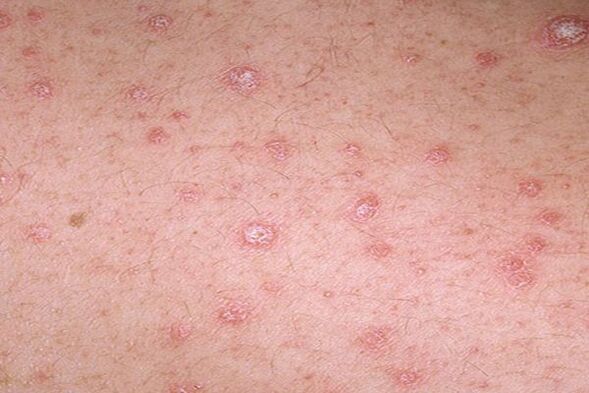
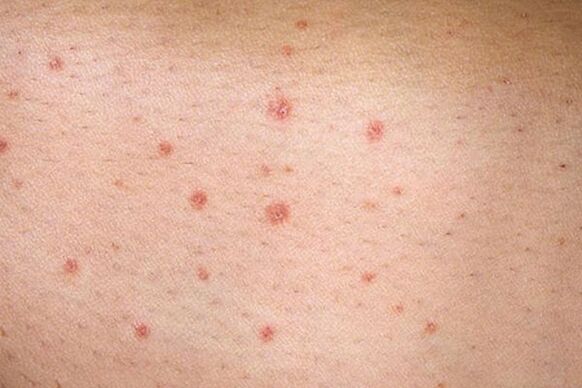
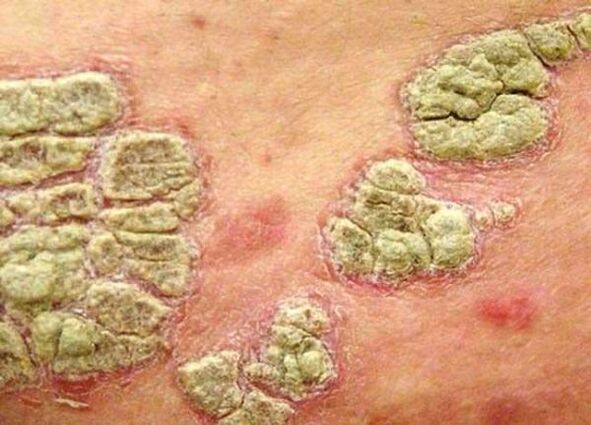
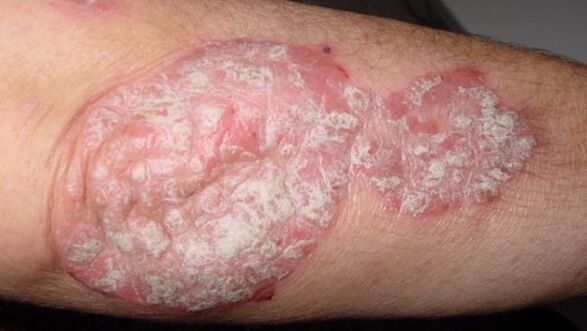
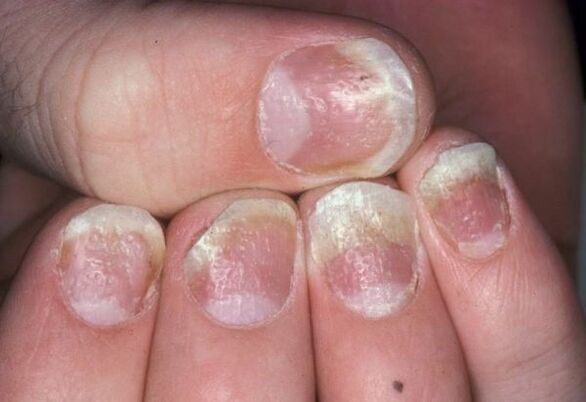
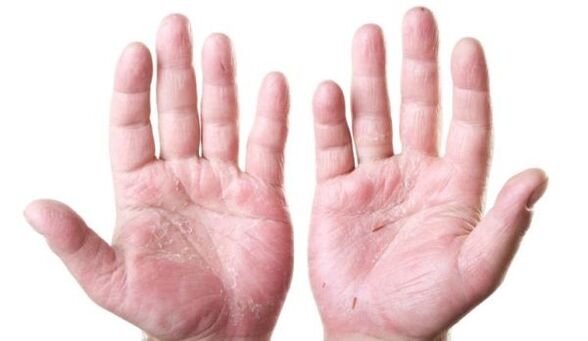
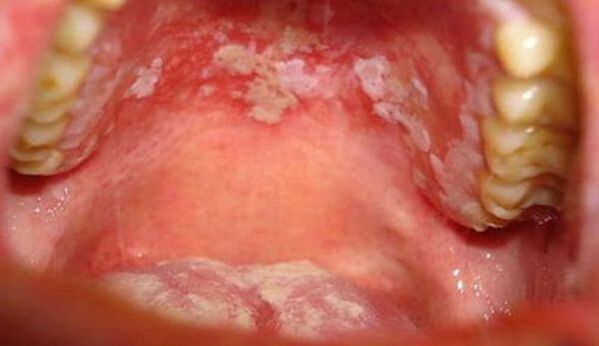
Localization of psoriasis
HANDS
In most cases, rashes appear on the surface of the elbows or between the toes. Rarely, papules are noted on the forearm.
Attention!The hands are characterized by a plaque form of pathology, but others are also found. Its mark is small spots of a red color, quickly covered with white scales, the affected skin coarsens.
pins
Psoriatic formations occur mainly in the foot in the knee area, but it is possible for them to form in other parts of the foot.
The first blush is single and small with a clear but loose, glowing and very light outline. These certain papules spread rapidly to form conglomerates.
HEAD
Often develops against the background of seborrhea, affects the hairline, forming the so-called psoriatic crown. Skin formations gradually grow and spread all over the surface, resembling dandruff. This localization occurs quite often, less often a rash appears on the ear or behind them.
Fingernails
Nail plate can be affected by the type:
- Thimble- point form of psoriasis. Small holes appear on the nails, which resemble needle traces.
- Onychomycosis- the nail changes color, becomes dull, thickens significantly and begins to shed. Through the plaque, a psoriatic papule surrounded by a reddish edge is visible, resembling an oily spot.
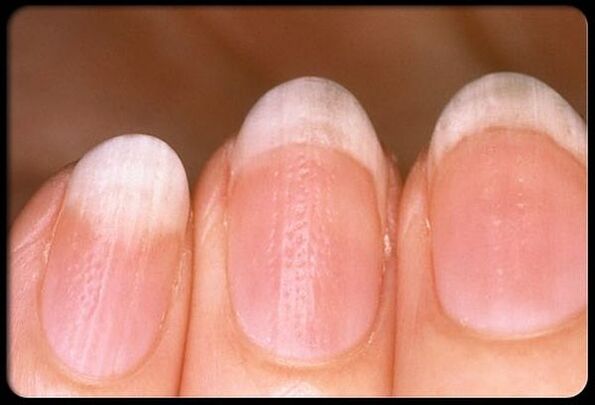
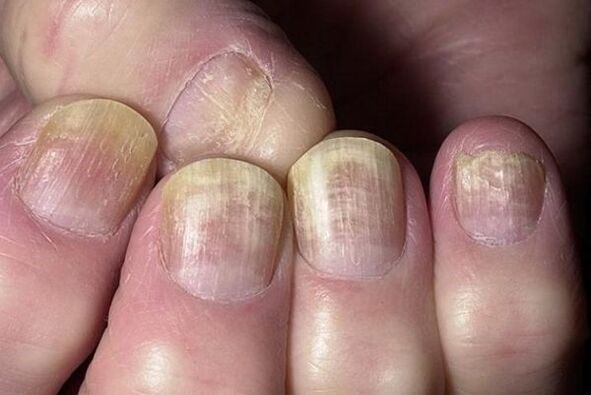
body
It usually manifests as characteristic papules that merge with each other. Psoriasis is more common in the back, less often in the neck, abdomen, groin, the formations can be in the form of spots, in the form of spots and plaques.
Face
Rarely affected, the rash is located on the nasolabial folds, in the area of the temples and eyebrows, around the eyes. Rarely, the pathology affects the border of the lips, the rash resembles herpes.
Palms and feet
Both areas are affected simultaneously, but there have been cases where the pathology develops only in the foot or palm. In the feet, the disease is often combined with fungal pathology, which greatly complicates diagnosis and therapy.
This type of psoriasis is divided into 3 types:
- Papular plaque- the formations are dense, do not protrude above the skin, it is difficult to separate the stairs from the slab. Rash occurs in marginal areas, accompanied by edema and keratosis.
- Psoriatic calluses- dense round papules, consisting of keratinized epidermis. The skin layer gradually thickens and thickens. As a result, it is easily damaged, cracks appear. Virtually no redness, the size of the growths is from 2-3 millimeters to 2-3 centimeters.
- Vesicular-pustular- manifests itself in the form of seroso-purulent papules. The bubbles reach a diameter of 2 millimeters and tend to coalesce.
Nodes
Pathology can affect a person’s joints, leading to a change in the structure of their tissues, which, as it progresses, leads to soreness and deformity. External symptoms: a reddish rash appears on the skin. Internal signs - joints hurt, especially during sleep, stiffness of movement, swelling is felt.
Important!First, psoriasis affects the small joints of the feet and hands, then it spreads to the knee and elbow and at an advanced stage, the intervertebral joints already suffer.
Itching or not
In most cases, psoriatic disease is accompanied by itching of varying degrees of intensity, sometimes not just spots, but itching all over the body. In the initial stage, itching is easy, gradually increasing.
The degree of intensity also depends on the location of the pathology. For example, psoriasis on the head itches a lot while the skin is peeling and falling into large flakes, larger than normal dandruff. In the stationary phase, the itching is reduced, often giving way to a burning sensation. During remission, all the main symptoms are mild.
Itching worsens with:
- return;
- climate change;
- general intoxication;
- diseases of the digestive tract;
- acceptance of scabies, allergies;
- HIV infections.
The skin itches badly after drinking coffee, alcoholic beverages, spicy and spicy foods, chocolate and other allergens.
How to distinguish
For eczema
- The nature of the rash.With eczema, blisters or blisters fill with fluid that flows periodically. Psoriasis is characterized by the appearance of dry scaly papules, when removed, blood appears.
- Itchy skin.From eczema, the body itches more than with psoriatic pathology.
- Color.In psoriasis, the scales have a silvery color, and in eczema, the affected areas become bright red or reddish red.
- Injured areas.Eczema affects the soft, sensitive areas of the skin, armpits and hips. Psoriasis is characterized by a rash on the skin in rough, hard and thick layers (knees, elbows, head and others).
- Causes of the disease.Psoriasis is often caused by neurogenic factors and eczema is caused by allergies and body dysfunction.
- Features for redness on the hands.With psoriasis, pits form on the nail plate and eczema is similar to a fungal infection.
For seborrheic dermatitis
The clinical manifestations of the disease are similar, but there are some characteristics with which you can distinguish them:
- for psoriasis, an unhealthy skin glow and bloody cracks are characteristic, and this is not noticed with seborrheic dermatitis;
- dermatitis, unlike psoriasis, is not associated with thickening of the skin and severe dryness of it;
- with psoriasis, the scales are silver and the seborrhea is yellow or white;
- seborrheic scales are easily removed, but psoriatic ones are not;
- dermatitis is most often observed in places of accumulation of sebaceous glands and scaly disease - throughout the body;
- scalp psoriasis protrudes significantly beyond the area of hair growth and seborrheic pathology does not cross this line;
- the lesion area with squamous lichen is much larger than that of dermatitis.
From the fungus
- Psoriasis occurs in the presence of several provocative factors, for example, heredity, mechanical damage to the skin, dysfunction of the immune system, etc. The causative agent of the second disease are only the spores of parasitic fungi.
- Psoriatic pathology is not contagious, it is not transmitted either by airborne droplets, or sexually, or by touch.
Attention!Fungi (onychomycosis) affect any contact, including in public places - a sauna, a swimming pool, gym, etc. Transmitted by animals and humans.
- With scalp psoriasis, the structure of the hair does not change, while fungal disease leads to brittleness, dryness and hair loss.
- Unlike scaly lichen, onychomycosis of the feet and legs is accompanied by an unpleasant odor.
- With the loss of scaly nails, their structure already changes in the initial stage and with a fungus for a long time, the structure and color of the nail plates do not change.
From pink lichen
The hallmark of psoriasis is the "psoriatic triad. "The disease gradually increases and goes through 3 stages. Pityriasis rosea (pityriasis) develops rapidly and constantly progresses. In addition, pityriasis is a contagious disease, but scaly lichen is not.
From neurodermatitis
- Atopic dermatitis (neurodermatitis) is of allergic origin and is triggered by a certain substance, for example, plant pollen, food, animal hair, etc. The causes of psoriasis are different (heredity, reduced immunity, psychosomatics, mechanical skin damage, etc. ).
- With neurodermatitis, the skin becomes dry and rough, and with psoriasis it becomes scaly and bleeds.
- Dermatitis plaques consist of small special elements, in the case of herpes, the papules are uniform and covered with silvery scales.
- The color of the rash with psoriasis is much brighter than with neurodermatitis.
For gout
The difference between gout and psoriatic arthritis lies in the cause of development. Gout occurs when uric acid crystals are deposited in the articular cartilage. Deviation from the norm can be provoked by: hypertension, overweight, taking diuretics, drinking alcohol, etc.
The symptoms of psoriasis and gout are similar - severe pain at night, stiffness in movement, redness and swelling in the affected area. However, with psoriasis, in most cases, characteristic red rashes appear first, and then pain.
Other distinguishing symptoms of gout include:
- the presence of white nodules in the affected nodule area;
- signs of kidney stones (back pain, blood in the urine and others).























